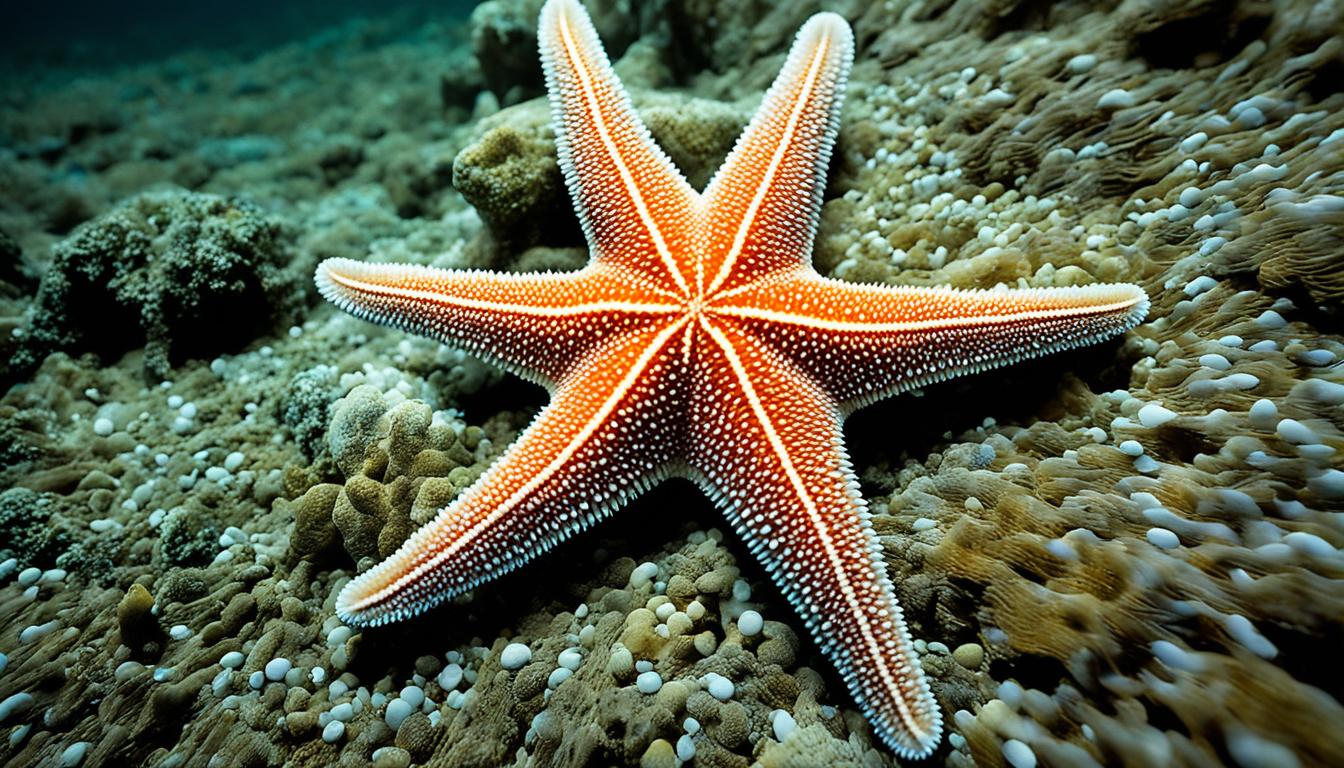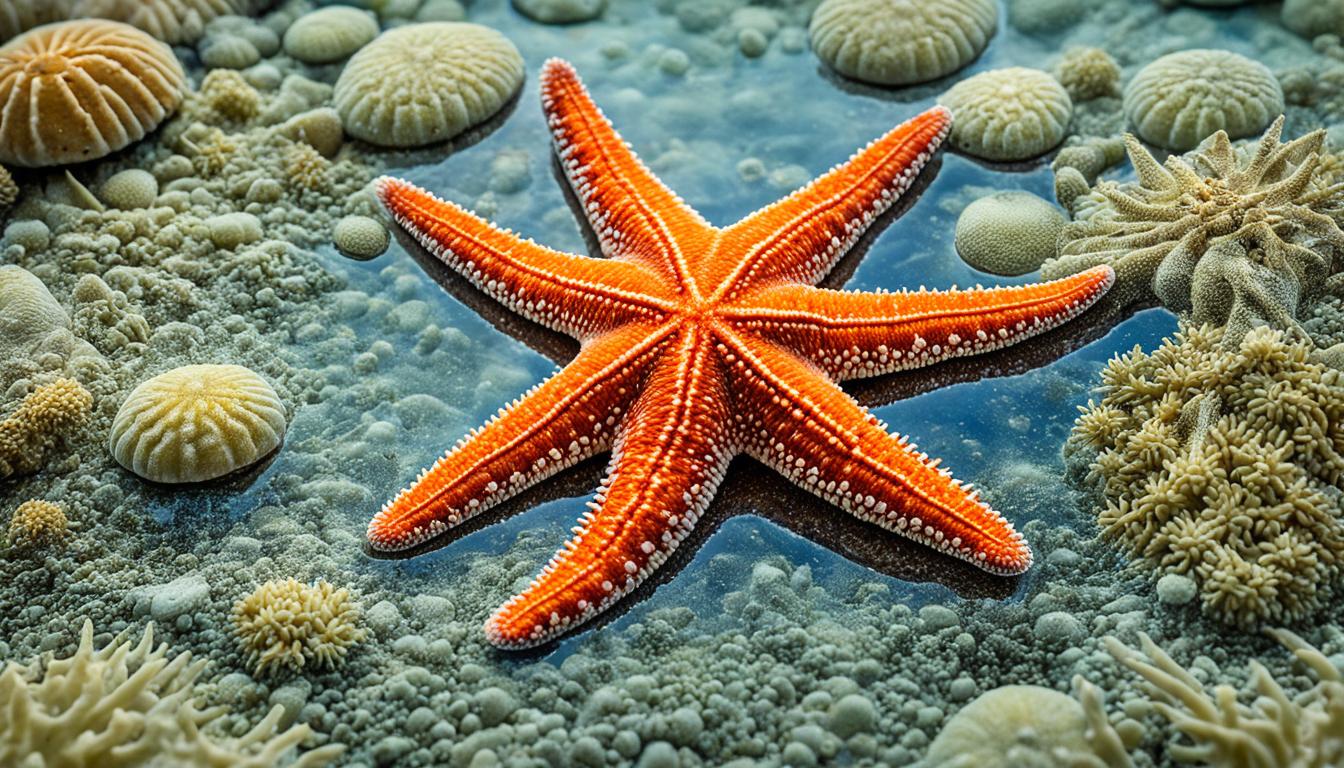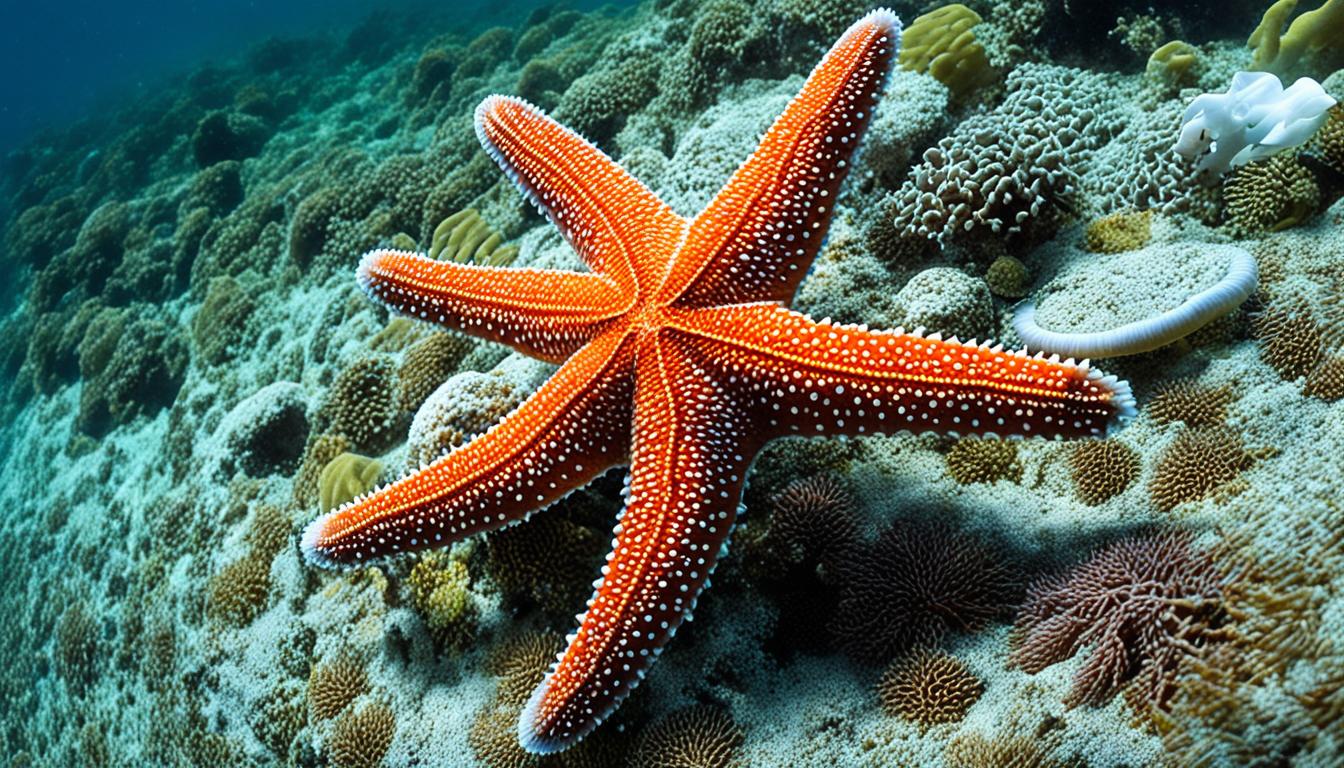Starfish, or members of the class Asteroidea, have amazing starfish sensory abilities. These abilities are key to their survival in the ocean. They don’t have a traditional brain but have a decentralized nervous system instead. This setup makes you wonder: how do starfish know what’s around them? Studies show they use senses like touch, gravity, and vision to move through the ocean.
Introduction to Starfish Sensory Abilities
Starfish live in a world full of unique adaptations that help them survive in different marine places. These creatures have special ways to sense their surroundings. They use their senses to interact with the world around them.
Starfish use mechanoreception and chemoreception to sense their environment. Mechanoreception helps them feel changes in water currents. Chemoreception lets them detect chemicals in the water. These senses show how complex starfish perception is.
They also have behaviors like positive rheotaxis, moving towards currents. This helps them find food and move around their home. It shows how adaptable they are.
Studies on starfish are still uncovering more about their senses. As we learn more, we see how these creatures survive in the ocean. It’s fascinating to see how they use their senses to live in their underwater world.
| Type of Sensory Ability | Function | Example Behavior |
|---|---|---|
| Mechanoreception | Detection of water movement | Positive rheotaxis |
| Chemoreception | Sensing chemicals in the water | Locating food sources |
| Photoreception | Responding to light changes | Movement towards light sources |
Understanding Starfish Perception Mechanisms
Starfish have amazing ways to understand their world. They have special senses that help them move, find food, and stay safe.
Starfish don’t have a single brain but have a nervous system spread out in their bodies. This lets them feel and taste things all over. They use special receptors on their skin for touch and taste.
- Chemoreception: Starfish can pick up on chemical signals in the water. This helps them find food or a mate. It’s key for surviving in different ocean areas.
- Mechanoreception: They feel things like water movement and vibrations. This helps them move and know what’s around them.
- Visual Inputs: Even without eyes, starfish can sense light and dark. This helps them react to their environment.
Starfish can adapt to many ocean environments thanks to their complex senses. Using many senses helps them do well in tough places.
How do starfish sense their environment?
Starfish have amazing ways to sense their world, which helps them survive. They use chemoreception and mechanoreception to do this. These senses let them know what’s around them and how to react.
The Role of Chemoreception in Starfish
Chemoreception is key for starfish to find food and move around underwater. They have special organs that can pick up chemical changes in the water. This lets them spot food from far away.
Thanks to their chemoreceptive system, they can find food easily. This is important for their survival in the ocean.
Mechanoreception: Starfish and Touch Sensation
Starfish also have a sense of touch through mechanoreception. They have sensory cells in their tube feet. These cells help them feel pressure, texture, and vibrations.
This touch sense is vital for moving over rocky floors, hunting, and avoiding dangers. It shows how sensitive starfish are to their surroundings. This helps them live in the complex ocean world.
Starfish Sensory Organs and Their Functions
Starfish have amazing sensory organs that help them live in the ocean. Each organ helps them find food, avoid dangers, and live in different places. They can see, feel, and even sense things in ways we can’t.
Compound Eyes: An Overview of Starfish Vision
Starfish have compound eyes at the end of their arms. These eyes help them know where they are going and what’s around them. They can see stationary things like coral reefs and tell them apart from the moving ocean.
This helps them survive in their ocean home.
Other Sensory Adaptations in Starfish
Starfish don’t just see their world; they also feel it. They can tell when they’re upside down or right side up. Some might even feel electrical signals in the water, though we’re still learning about this.

| Adaptation Type | Function | Importance to Survival |
|---|---|---|
| Compound Eyes | Light detection | Navigates and orients in the ocean |
| Chemoreception | Sensing chemicals in the water | Locates food sources |
| Gravitational Response | Detecting changes in gravity | Maintains balance and position |
| Electroreception | Potential detection of electrical fields | Enhanced environmental awareness (ongoing research) |
Starfish Sensitivity to Their Surroundings
Starfish show us how they adapt to their environment through their behavior. Studies show that starfish sensory biology helps them sense and react to their surroundings. They have amazing awareness of their environment, helping them live in many different places.
Behavioral Evidence of Environmental Detection
Research on starfish shows they are very good at sensing their surroundings. For example, they can solve y-shaped mazes to find their way through the water. This proves they have strong sense of smell and helps their starfish environmental awareness.
- Starfish can find food by smelling chemical signals in the water.
- They react to different things in their environment, showing they are adapted to challenges.
- Their senses help them survive.
The way starfish use their senses and react to their environment shows how they survive. They can sense and move around using cues from their surroundings. This makes them stand out in the ocean.
| Behavioral Observation | Description |
|---|---|
| Chemical Detection | Starfish can identify food and predators through chemical signals in the water. |
| Movement Patterns | Their ability to navigate is clear during feeding. |
| Touch Sensitivity | Starfish show a strong reaction to touching things around them. |
The Importance of Sensory Biology in Starfish Survival
Learning about starfish sensory biology is key to understanding how they survive in the sea. These creatures use many senses to adapt, find food, and move through their world. This lets them live in changing environments with great skill.
Starfish are important in the ocean because they help keep the balance. Their senses help them survive and also keep their homes healthy. For example, they can smell out food and avoid danger, which helps the whole ecosystem.
Studies on starfish senses give us new ways to help protect them. This is very important for species like the crown-of-thorns starfish, which can harm coral reefs. Knowing how starfish survive and sense their world helps us protect them and our oceans.










